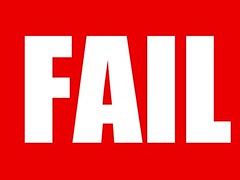Email gone wrong can get really ugly. There’s spamming people, there’s lack of permission, there’s confusing messages, and sometimes there’s just plain stupidity.
Here are several truly awful email marketing failures.
Read these and spare yourself the horror and embarrassment of these awful mistakes!
Me, me me! (an email marketing disaster)
So, a salesman really wants to win a company sales prize. He sends out an email – telling his clients if they act soon they get a $25 certificate. Not bad, but the prize he would get for winning the contest was much, much better. If you want to encourage people to do something, it should solve their problem, not yours.
Oops, no permission
I signed up for an event at a restaurant. The place kept my name and started filling my inbox with coupons. Event signup (particularly through a third party) doesn’t equal marketing permission.
Irrelevant offers
Attention marketers, sending ads for diapers to someone who just bought razors makes no sense. How about a coupon for shaving cream instead?
BCC to everyone!
(Bangs head on desk). I’ve seen people calling themselves experts say this, people on Linkedin, it’s everywhere. Do not use bcc to send marketing emails with Outlook or Mail or any other email software. Use a proper ESP.
Oops, no content
An email newsletter recently arrived in my inbox, with only the words “message here.” Um, nope, not opening that. It went straight to the trash folder.
Data failure (x3)
I got an email from an affiliate company warning me that their records showed I was using a tool that was being discontinued. Actually, I wasn’t using it at all.
Then last week LinkedIn emailed me suggesting I join 4 groups – 3 of which I already belong to.
Here’s another one; US Airways sent a reward email to the wrong list. Then, didn’t make it up to them in any way.
It’s electronic!
A car dealer sent out an email that was just one big image. It looked blank if you had images turned off. If you went to the trouble to download the image (which was very large), it was just a reproduction of a handout flier.
If you’ve been marketing offline, adapt your offline marketing to the web. Don’t make, well, a “meatball sundae.”
What’s the biggest, worst email marketing failure you’ve seen? Or received?




